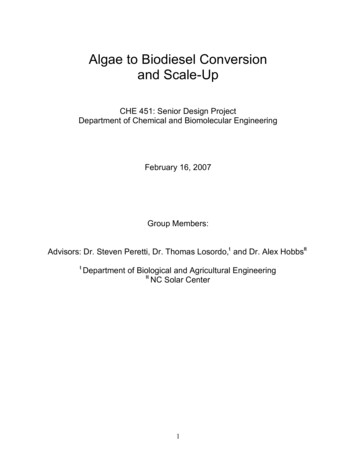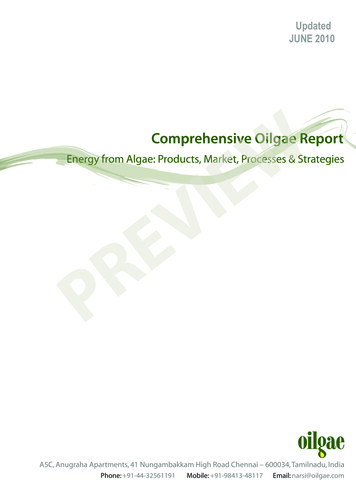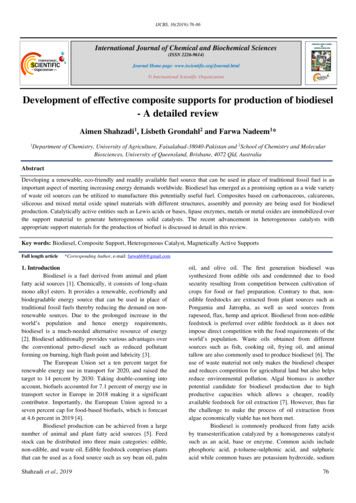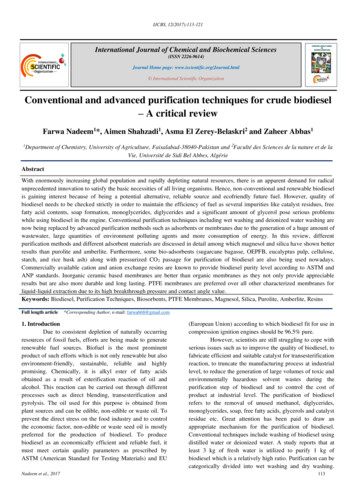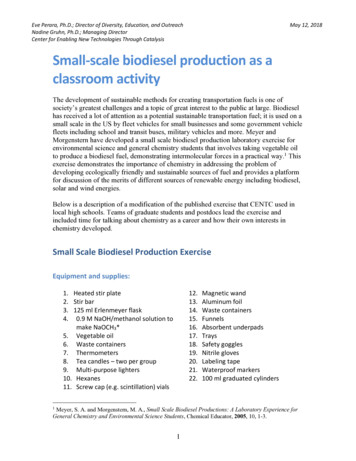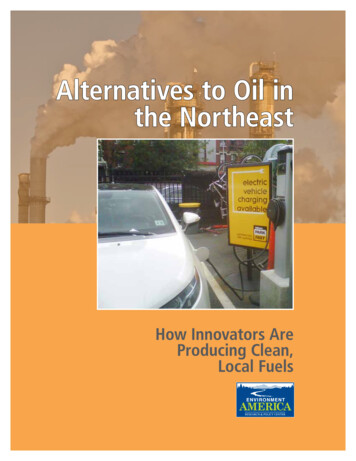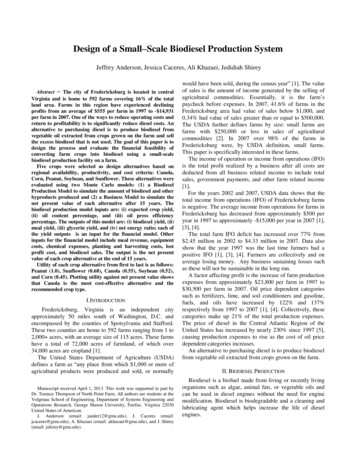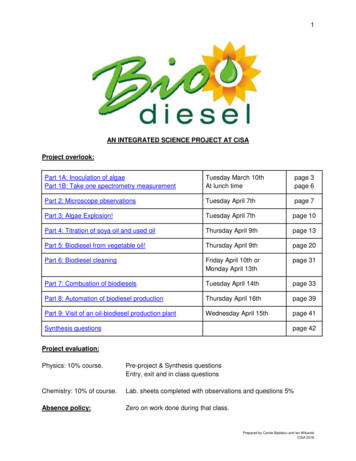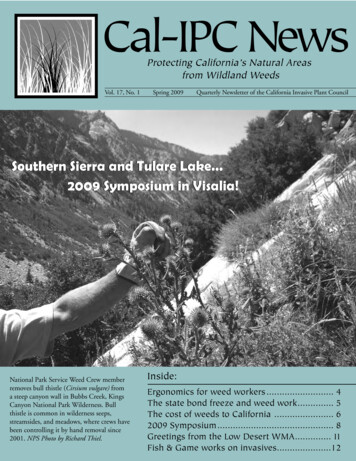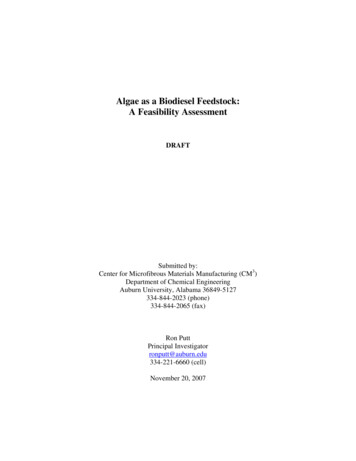
Transcription
Algae as a Biodiesel Feedstock:A Feasibility AssessmentDRAFTSubmitted by:Center for Microfibrous Materials Manufacturing (CM3)Department of Chemical EngineeringAuburn University, Alabama 36849-5127334-844-2023 (phone)334-844-2065 (fax)Ron PuttPrincipal Investigatorronputt@auburn.edu334-221-6660 (cell)November 20, 2007
Table of Contents: Executive Summary Introduction Overview of this Report Nutrients Animal Husbandry Summary Algae Growth Kinetics Overall System Design Digester Pond Carbonation Harvesting Experimental Program Economic Analysis The Next Step References13457791010121214162021Appendices:A. Air-to-Pond Carbon Dioxide TransportB. Means of Enhancing Air-to-Water Carbon Dioxide TransportC. Carbon Dioxide Stripping from Diesel Exhaust GassesD. Pond Mass BalanceE. Paddlewheel PowerF. Digester for Animal LitterG. HarvestingH. Dewatering and DryingI. Energy Balance222428333436394143
Executive SummaryAlabama has an immediate opportunity to lead the nation in becoming self sufficient withrespect to liquid fuels for transportation. Mass cultivation of micro-algae in the state,using less than 3% of our land area, could produce the 3 B gallons of fuel we need everyyear. Through careful design and efficient operation of algae farms, the payback on theinitial investment would be within a few years, which makes algaculture an attractiveinvestment opportunity on its own. Factoring in the geo-political benefits of energy selfsufficiency and closing the loop on the carbon cycle makes the proposition of statewidealgaculture compelling. With the potential for production rates exceeding 4,000 gallonsof biodiesel per acre annually, algae-to-biodiesel is unique among the alternative fuelsconcepts in having the potential to be a 100% solution for our transportation fuel needs.The seminal work on algae-to-biodiesel within the U.S. was the U.S Department ofEnergy Aquatic Species Program performed by the National Renewable EnergyLaboratory (NREL) from the mid 1970’s through the mid 1990’s in response to thenation’s first energy crisis. The original goal of the ASP was carbon dioxide mitigation,but early on they realized the biodiesel feedstock potential of micro-algae, and thereforeredirected the program. Two key technology development needs were identified duringthe ASP, namely the cost and energy efficient means of (1) providing sufficient carbondioxide to the ponds to support the high growth rates inherent to micro-algae, and (2)harvesting dilute (200-300 ppm) micro-algae from the pond water. The program was shutdown by DOE in the mid-90’s when gasoline returned to 1 per gallon.The present assessment, performed under contracts to the Choctawhatchee, Pea, andYellow Rivers Watershed Management Authority and the Alabama Departments ofEconomic and Community Affairs and Agriculture and Industry, with cost sharing by theAlternative Energy Committee of Auburn University, was for technical and economicfeasibility of statewide algaculture in Alabama for the production of biodiesel feedstocksfrom algal oil, and nutritional and animal feedstocks from algae meal. It consisted ofexperimental investigations, technology development, interviews with governmentagencies and private enterprises, and an engineering design and cost analysis. Theassessment, as discussed herein, developed solutions for the challenges of providingsufficient carbon dioxide to the ponds and harvesting micro-algae using commerciallyavailable technology.There were several important innovations during the course of the program, namely (1)integration of animal litter digesters to provide nutrients and energy for the algae farms,(2) integration of carbonation pits and their pumps with a novel linear pond design, (3) alow-cost harvesting system, and (4) a scheme for integration of algaculture with catfishaquaculture to improve the competitiveness of this industry within the state.The economic analysis estimated an installed cost for 100 acre algae farms of less than 1million, and annual nets of 200,000. The analysis identified key cost and price variableswhich are likely to have the biggest impact on the economic performance of the algae1
farms, including those for petroleum crude, algal oil and meal, carbon from carbondioxide capture, and commercial fertilizer.The assessment resolved three phases to algaculture within Alabama, two near term andanother somewhat longer term. The near term phases employ animal litter as the nutrientsource for the algae ponds.One phase would involve digesting poultry litter and cattle manure in an anaerobicdigester which would produce methane, and carbon dioxide, to power a diesel generatorthat would provide electrical and thermal power to run the farm. The exhaust of the dieselgenerator would provide the heat for a drum dryer at the end of the algae harvestingsystem, and the cooled, carbon-dioxide rich exhaust would then feed the algae pondwater via gas-liquid exchange in a carbonation pit. All the poultry litter and cattle manurein Alabama would provide about 2% of the nutrients for the state’s liquid transportationfuels via algae-to-biodiesel.The other near-term phase would integrate algae ponds with catfish ponds. Using algaeponds to remove catfish litter from the catfish ponds at an accelerated rate would improvethe yields of the catfish ponds dramatically. The algae ponds would also hyper-oxygenatethe catfish pond water and reduce, or eliminate, unwanted algae blooms in the catfishponds. Productivity from the catfish ponds could easily triple, and the revenues from thealgae ponds would match those of the catfish ponds. While the production of algae fromthe catfish farms would be only a small fraction of that from the poultry and cattle farms,it could have a significant beneficial impact on cost and quality for Alabama’s catfishindustry.The longer term phase of algae farming would require capturing carbon dioxide fromfixed and vehicle point sources in the state. An international movement is underway toscrub carbon dioxide from stack gases and then compress it for underground storage. Abetter solution would be to feed them to algae ponds. The carbon dioxide from AlabamaPower’s fossil-fuel fired power plants would provide 50% of the state’s transportationfuels via algae-to-biodiesel. And a Welsh company, Maes Anturio Ltd, has a “greenbox”technology that can capture up to 90% of the carbon dioxide produced by vehicleengines; their original purpose in developing this technology was to feed algae farms.While these means of providing carbon dioxide are several years away, it would likelytake the intervening years to perfect and implement algaculture on animal litter.A credible scenario therefore exists in which algaculture can provide all the liquid fuelsrequired for transportation within the state of Alabama. This scenario is financiallyattractive on its own, and the added benefits of sustainable energy self-sufficiency andclosing the loop on the carbon cycle compel us to give it serious consideration.2
IntroductionWidespread cultivation of micro-algae has the potential to make Alabama, and the UnitedStates, self-sufficient in liquid fuels for transportation. Alabama could produce its 3 Bgallons per year of transportation fuels from 1 million acres of algae ponds, which areonly 3% of our land. This amount of acreage is not unreasonable to consider, since thestate currently has more than 150,000 acres of man-made ponds, including recreational,farm, and aquaculture ponds.Fuels from algal oil could either be biodiesel, which is a methyl ester produced via astraightforward reaction between most any vegetable oil and methanol, or straight (socalled “green”) diesel, which is essentially the same as petro-diesel. Microalgae, asplants, store energy as carbohydrates and lipids, and these lipids are similar to thoseproduced by row crops such as soy. Algae lipids can be extracted via processes similar tothose used for soy, and sold to Alabama’s biodiesel producers, who are currently lipid feedstock-limited. The meal remaining after extraction is rich (about 50%) in protein, andcan therefore be used as a high-value ingredient in animal feeds.The seminal work on algae-to-biodiesel was performed in the wake of our nation’s firstenergy crisis (mid 70’s to mid 90’s) by the U.S. Department of Energy’s NationalRenewable Energy Laboratory (NREL) in Golden, Colorado, whose original mission forthe algae project was carbon dioxide mitigation (Sheehan 1998). During the early yearsof their program they discovered that some of the algae species were capable ofproducing 50% or more of their weight in lipids, under the proper growth conditions, andthe program therefore transitioned to algae-to-biodiesel. The program included laboratoryand field work to identify the most promising species and to optimize growth conditionsfor maximizing lipid yield per acre. Their key findings were that (1) high-rate openponds, capable of producing 30 grams of algae per square meter per day, at 30% lipidscontent (yielding 4,000 gallons of biodiesel fuel per acre annually), would be the onlycapital-cost effective approach (as compared with a variety of enclosed photobioreactors)for producing lipids for transportation fuels, (2) native species of algae should be used,since they would take over the ponds anyway, and (3) the price of biodiesel producedfrom algal lipids would be in the 2-4 per gallon range. The program was shut down inthe mid-90’s when gasoline returned to a dollar per gallon.After a careful study of their report, we additionally concluded that (1) the southeasternregion of the U.S. is the best location for widespread algaculture owing to our abundanceof pond-capable land, fresh water, sunshine, and animal husbandry, (2) algaculture needsto be intimately coordinated with animal husbandry, owing to the complementary naturesof the plant and animal kingdoms with respect to nutrient needs and waste products, and(3) significant engineering would be required in the areas of nutrient feeds (notablycarbon, nitrogen, and phosphorus) to the ponds, pond design, and the harvesting process.Now that gasoline has reached 3 per gallon, and with the ongoing political and militaryupheaval in the Mideast, we as a nation recognize the urgent need to identify and developalternative fuels for transportation. Alabama’s Departments of Economic and CommunityAffairs, and Agriculture and Industry, along with the Choctawhatchee, Pea, and Yellow3
Rivers Watershed Management Authority, have therefore commissioned AuburnUniversity to perform a technical and economic assessment of algaculture for biodieselproduction in our state, with Auburn University’s Alternative Energy Committee as acost sharing partner. The results of the assessment, contained in this report, are to serve asinput to the decision-making process by the state and private industry as to what furthersteps should be taken toward commercialization of algaculture here.Overview of This ReportThis report, as a reflection of the assessment itself, is organized based on the nutrientneeds, specifically carbon dioxide, of microalgae for growth at economically practicalrates ( 20 grams per square meter per day averaged throughout a 300 day growingseason). We have learned during the assessment that atmospheric carbon dioxide, despiteconcerns about its increased concentration during the past two hundred years and thesubsequent contribution to the so-called “greenhouse effect”, is far too dilute (350-500ppm by volume) to support this minimum economically viable growth rate.Open ponds, even with paddlewheel mixers, would only absorb 1% of the daily carbondioxide required. Efforts to improve the air-to-pond transport of carbon dioxide to meetthe required growth rates, such as bubble column or wetted film contactors, wouldrequire more energy input than that produced by the ponds, and they would beprohibitively costly. This is why, in all the prior and current work on algae-to-biodiesel ofwhich we are aware, concentrated (10% or more) carbon dioxide is supplied to the pondwater. The NREL work focused on fossil-fuel power plant stack gases; other point-sourcecarbon dioxide emitters include cement and lime plants, pulp and paper plants, breweriesand other fermentation processes, and animal waste digesters.Discussions with electric utility companies, cement plants, and pulp and paper millsconducted during the assessment revealed that, at least today, capturing the carbondioxide emissions from the stacks would be complicated and expensive. Further,insufficient available land exists adjacent to these plants for growing the algae required toconsume even a significant fraction of the carbon dioxide emitted. This is unfortunate,since Alabama Power exhausts enough carbon dioxide to support half of the state’s liquidtransportation fuel needs, via algae-to-biodiesel.We therefore turned to the state’s animal husbandry industry for carbon sources. Thepoultry litter from Alabama’s chicken houses is currently sold as a fertilizer for landapplication; the manure from our dairy and beef cattle is generally left in the field todecompose. Land application of poultry litter is becoming an environmental concern,owing to phosphate buildup and runoff which result in unwanted algae blooms in ourwaterways.One option for beneficial use of animal litter would be to feed it to anaerobic digesterslocated at algae farms. Digesters would convert the volatile organic compounds in themto methane and carbon dioxide, the former of which could be used to generate electricaland thermal energy for the farm. The carbon dioxide from the engine generator exhaustwould be scrubbed by the pond water. Nitrogen, phosphorus, and trace metal nutrients4
from the litter which leach into the digester water would be sent there as well. The massbalances show that the nutrient content in the animal litter is generally what the algaeneed for healthy growth.The assessment examined animal litter as the first source of carbon for the ponds, viaanaerobic digesters which would produce methane for the algae farms as well as carbonand other nutrients for the algae. The farm is thus designed based on the integration of ananaerobic digester and high rate algae growth ponds. This design also includes theharvesting system, which saw significant experimental development during theassessment. The challenge in harvesting is to remove suspended microalgae whose pondconcentration is about 200 ppm (5,000 grams of water per gram of algae) via dewateringand drying operations which yield a product that is more than 90% dry solids, whilestaying within very tight cost and energy constraints.Poultry litter and cow manure would provide at most 2.5% of the annual carbon requiredfor our transportation needs. Although full implementation of algaculture supplied bydigesters would take several years to implement and would serve as the first commercialopportunity for algaculture, we must find a much larger source of carbon if our goal is tosupply all of our transportation needs via algae-to-biodiesel.For this we turn to recent developments in the field of carbon dioxide capture, both at thepower plant and vehicle level. There are programs internationally to capture andsequester carbon dioxide emissions from stationary point sources, particularly powerplants, and vehicles. The former (see, for example, www.co2captureproject.org) wouldcompress the carbon dioxide and pump it into underground caverns. Instead, the carbondioxide could be barged up or down river to algae farms. The latter is in demonstrationby a Welsh company, Maes Anturio Ltd., whose end use for the carbon dioxide would bealgae farms. Both of these opportunities are several years away from fruition and beyondthe scope of the present study, which will therefore focus on present day sources ofcarbon dioxide and the other nutrients, namely animal litter.NutrientsFor the fast-growing algae species under consideration by this program, pondproductivity during the growing season of February through November would benutrient-limited. The rate of feeding nutrients to the pond is therefore of paramountimportance in setting the overall direction of the algaculture program. This appliesparticularly to carbon. Supporting a growing season’s average growth rate of 20 gramsper square meter per day, with a range of perhaps 30 in the warmer months to 10 in thecooler, requires the addition of 10 grams of carbon per square meter per day on average,since algae are about 50% carbon. If the source of the carbon were atmospheric carbondioxide alone, the rate of carbon dioxide uptake from the atmosphere by the pond wouldhave to be 40 grams per square meter per day average, since carbon dioxide is about 25%carbon. Unfortunately the uptake of ponds by atmospheric carbon dioxide is 1% of thatrequired (Appendix A).5
We considered means of increasing the rate of carbon dioxide uptake (Appendix B),including sparging air bubbles up through a vertical tank, through which the pond waterwould be circulated, and by creating a thin wetted film atop a ramp elevated above thepond surface, along the top edge of which the pond water would be pumped.Unfortunately, within the limits of reasonable energy budgets and equipment sizes forthese means of air-pond water contacting, the rates of carbon dioxide uptake by the pondwater are still far from adequate. The reasons for this are (1) the low (350 ppm (V))concentration of carbon dioxide in the atmosphere, and therefore (2) the low (milli molar) solubility of atmospheric carbon dioxide in the pond water; supplemental sourcesof carbon are required.Fortunately Alabama is an ideal state for providing these supplemental carbon sourcesthrough our animal husbandry, namely poultry and cattle. These sources also provide theother nutrients required by the algae, notably nitrogen and phosphorus. This should notsurprise us, since the plant and animal kingdoms were designed to be completelycomplementary by their Creator.Poultry: Alabama produces 1 B chickens per year statewide, which produce 2 B poundsof litter; this litter is sold as a fertilizer for row crops. Over the years the high phosphatelevels in the litter have caused phosphate buildup in the fields, with subsequent runoffinto streams, rivers, and Mobile Bay, where unwanted algae blooms occur. ADAI istherefore looking for other beneficial uses of the litter to avoid these blooms.An excellent use would be for feeding algae ponds. The means of feeding the pondswould ideally be via animal litter digesters, where the volatile solids would be convertedby anaerobic bacteria to methane and carbon dioxide. The methane would be combustedto produce electrical and thermal energy for the algae farm, and the exhaust scrubbed ofits carbon dioxide by the pond water. Using digesters for the poultry litter wouldtherefore make inorganic carbon available to the ponds, as well as all the other nutrientsfrom the litter, while providing an important source of energy for the farms. The algaefarms would be energy self-sufficient (Appendix I), since the 26 kW of methaneproduced by the digester, for each acre of algae pond fed, are well more than required.If all the carbon content of the poultry litter produced by the state were turned into algae,1.2 B kg of algae would be produced (at 30% carbon content of the litter and 50% carboncontent of the algae), which would then yield 32 M gallons of biodiesel at 20% lipidscontent of the algae; this would require 23,000 acres of ponds at a pond productivity of24,000 kg (53,000 pounds) of algae per acre.Cattle: 700,000 beef cattle are produced annually in Alabama. For a market weight of 800pounds and a manure production rate of 20 pounds per pound of animal per year, 6% ofwhich is carbon (half of the 12% volatile solids), 1.3 B pounds of algae could beproduced, which would yield 35 M gallons of biodiesel and which would require 25,000acres of high rate growth ponds. As with poultry litter, the manure would be fed to adigester to extract the methane content.6
Catfish: The catfish industry in Alabama provides a unique opportunity for algaculture.Alabama produces 100 M pounds of catfish annually, but competition from LatinAmerica and Asia is rapidly driving down our market share (by 30% in the past threeyears) and pricing (catfish fell from 85 to 65 cents per pound this year within a six weekperiod). We need a new competitive advantage in the face of these foreign imports.Catfish yields are typically 7,500 pounds per acre, or less, annually from the ponds inAlabama. The limit to this productivity is the rate of removal of litter by natural processesin the ponds, and buildup of litter in the ponds frequently results in algae blooms andcrashes, which affect negatively the taste and quality of the meat. AU Fisheries estimatesthat productivity could increase more than threefold if the litter were harvested, and aprogram is underway at Auburn University’s Fisheries Department to develop a suitablemeans to do so, in which the litter would be pumped out of the ponds, flocculated, settled,dewatered, and dried to pellets for use as dry fertilizer.An alternative would be to pump the litter-laden water from the catfish ponds to a highrate algae pond on the farm, where the algae, in combination with aerobic bacteria in thewater, would metabolize the litter and oxygenate the water; dense algae cultures canproduce up to four-fold supersaturation of oxygen in water, thereby obviating catfishpond aerators.The clear, oxygenated water from the algae harvesting process would be returned to thecatfish ponds. In this way catfish productivity could be increased dramatically and thelikelihood of harmful algae blooms and crashes in the catfish ponds reduced oreliminated. One acre of algae ponds on a catfish farm would be able to process the litterfrom four acres of catfish ponds, at a catfish productivity of 20,000 pounds per acreannually. And the revenue generated per acre by the algae pond would be about the sameas that for the catfish ponds.While this is an interesting option to consider for our aquaculture industry, the quantity ofalgae produced would be small in comparison to that produced by poultry litter and cattlemanure. We therefore will discuss it no further in the present analysis.Animal Husbandry SummaryIf we were able to turn the carbon content of all the poultry litter and cattle manureproduced in the state annually into algae, which are 50% by weight carbon and whichwould be at least 20% by weight lipids, 67 M gallons of biodiesel would be the result.These would provide 2.2% of the 3 B gallons of liquid fuels consumed by the stateannually for transportation.Algae Growth KineticsMuch of the research during the Aquatic Species Program at NREL was on algae growthkinetics, in their efforts to achieve the target production rate of 30 grams of algae persquare meter of pond per day; their approach was biological in nature. They wereoccasionally able to achieve the target growth rate, but not consistently. Based on ouranalysis of carbon transport rates to the ponds, and the published specific growth rates for7
various algae species, we believe that growth rate limitations are frequently those placedby nutrient uptake rate limitations of the ponds. This can be illustrated by example.Chlorella are fast-growing, robust, green micro-algae which are native to Alabama.Because of their rapid growth rates they usually dominate open ponds here. Lipidcontents in the 20-30 weight percent range have been reported for Chlorella, which, whilebelow those of some other species (50-70 weight per cent lipids have been measured), areadequate; soy is typically 20% lipid.Chlorella double in cell count every 8 hours or less if they have adequate nutrients andlight, for pond temperatures in the range 20-35 C. This corresponds to a specific growthrate constant u of 2.4 day -1 in the expressionP uC , whereDP is the growth rate,grams,m 2 dayD is the pond depth,and C is the alga concentration,grams(or ppm).m3For a specific growth rate constant of 2.4 day -1 and our target pond concentration of 200g,m3Pg 480 3 .Dm dFor a pond depth of 0.2 meters, the areal productivity is then 480 g (0.2m ) 96 g , m3 d m2 d 8
which is nearly 5 times our target growth rate of 20 grams per square meter per day.Therefore, achieving acceptable growth rates, in our view, requires providing nutrients ata rate sufficient to maintain those growth rates.Overall System DesignAn algae farm fed by animal litter would look something like the following:The digester would convert animal litter into methane and carbon dioxide gases whichwould flow to an engine/generator to produce electrical energy and an exhaust rich incarbon dioxide. The exhaust would provide heat for the drum dryer, and the high-ratealgae growth ponds would be fed this cooled exhaust via carbonation pits, one for eachpond, through which the pond water and diesel exhaust would flow countercurrently, sothat up to 90% of the carbon dioxide would be absorbed by the pond water. Solublenitrogen, phosphorus, and trace metal nutrients leached from the litter in the digesterwould flow to the ponds directly via makeup water pumped through the digester to theponds.The ponds would operate in a continuous, steady state mode. That is, the algaeconcentration, in the range 200-300 ppm, would remain essentially constant by thebalancing of the harvesting rate with the photosynthetic growth rate. The pond waterwould flow continuously to a harvesting system, where the algae would be removed byflocculation and settling, and the clear, essentially algae-free water, would be returned tothe pond.9
The settled algae, 1-3% solids, would be pumped to a belt filter press for dewatering andsubsequent drying over a series of drum dryers heated by the diesel exhaust. The driedalgae would then be packaged for shipment to a processor who would extract the oil fromthe meal.DigesterThe digester, a pit in the ground with a fabric cover, would receive animal litter slurriedwith makeup water in a feed pit. Anaerobic bacteria would metabolize volatile organiccompounds, producing methane and carbon dioxide which would be pumped through ascrubber and dryer on its way to the diesel generator. Stirring in the digester would be viaa circulation pump, and un-digested solids would be continuously removed for sale ascompost after dewatering and drying. The liquid flowrate through the digester wouldcorrespond to a residence time of at least 10 days.PondThe baseline design is the standard high-rate growth pond, developed during the past 40years, having an oval shape with a center wall and paddlewheel (Borowitzka 2005); areais one acre. This is typical of the ponds in the U.S. for growing Spirulina as anutraceutical.Economic analysis of a 100-acre farm (discussed later on in this report) revealed a strongincentive for increasing pond size to 10 acres. In doing this, the pond flowrate thenmatched the flowrate of the cantilever pump for the carbonation pit (see below), and werealized we could circulate the pond water with this pump, thereby eliminating the10
paddlewheel at significant cost and energy savings. Further, we located the carbonationpit within, and at one end, of a linear pond, and coupled two ponds via their cantileverpumps. This eliminates the regions of slow and eddy flow which exist in the racetrackdesign, where poor mixing and algae settling would occur.Circulation of the pond water would ensure that all the algae cells periodically make it tothe photic zone for photosynthesis to occur. Circulation would also ensure good mixingof nutrients and prevent significant thermal gradients. A practical velocity for the waterwould be one half foot per second, which is a compromise between mixing effectivenessand mixing power; mixing power is related to the cube of velocity, such that velocitiesmuch higher would consume an excessive amount of energy as compared with thechemical energy content of the algae produced.Key to the success of the algaculture program will be low cost and simplicity of theponds and the associated processes, and so we have chosen unlined earthen ponds for thebaseline design. Alabama is an excellent state for these ponds; there are presently150,000 acres of such ponds in the state for recreation, farm use, and aquaculture. Thecenter divider could be, as a minimum, a silt fence.The design production rate of the algae in the pond is 20 grams per square meter per dayas an annual average. The literature places an upper limit of 30-50 (Goldman 1995), andas the program matures we hope to get there, but for now we prefer a conservativenumber. We assume that the average is sustained during a 300 day growing season, withno production during the colder and darker months of December and January.11
CarbonationAir-to-pond carbon dioxide transfer would occur at 1% of the carbon dioxide uptakerequired to support the design growth rate of 20 grams per square meter per day, asshown in Appendix A. Artificial means of increasing this rate are impractical, as shownin Appendix B. We therefore require a concentrated (at least 10%) source of carbondioxide to feed the ponds, and this would be done via an in-ground carbonation pit,discussed in Appendix C. Carbon-dioxide rich diesel exhaust would first be cooledthrough the drum or belt-oven dryer in the harvesting system, then sparged up throughthe carbonation pit, where it would exchange carbon dioxide with pond water flowingdown into the pit. A cantilever pump would lift the carbon dioxide rich pond water fromthe bottom back to the pond. Given the high cost of the cantilever pumps, the farm wouldhave one carbonation pit for every ten acres of ponds.Harvesting12
The small size of most microalgae (1-30 microns), particularly Chlorella (2-10 microns)is a significant advantage in high rate growth ponds because the al
The seminal work on algae-to-biodiesel was performed in the wake of our nation's first energy crisis (mid 70's to mid 90's) by the U.S. Department of Energy's National Renewable Energy Laboratory (NREL) in Golden, Colorado, whose original mission for the algae project was carbon dioxide mitigation (Sheehan 1998). During the early years
